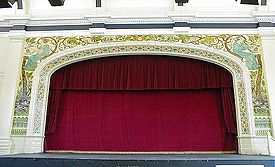
Juniper Productions
Encyclopedia
The Jubilee Theatre
The theatre was opened on May 30th 1900 Victorian with a beautiful proscenium arch of Doulton tiles by W.J. Neatby, depicting two pre-Raphaelite figures which face East & West, as the Theatre faces True North & South. It was built for Staff & Patients of the Hospital.The theatre was used to put on shows and also dances, with a sprung dance floor made from maple. Below this floor there is also a full sized orchestra pit, not used today but could be if part of the front of stage was removed as this has been extended recently covering the orchestra pit up.

There are two doors leading into the theatre from the corridor next to each other, this was because in those days the hospital was divided up men at one end and women at the other, the doors had to be entered left by men and right door by women, and when going through to the main auditorium men had to stay on the left and women on the right, they were only allowed to get together for dancing. Doctors and other staff sat next to the stage, and occasionally danced with a few patients.
On the men's side there was also a door out to the smoking promenade, which is now a fire corridor. Stan Laurel
Stan Laurel
Arthur Stanley "Stan" Jefferson , better known as Stan Laurel, was an English comic actor, writer and film director, famous as the first half of the comedy team Laurel and Hardy. His film acting career stretched between 1917 and 1951 and included a starring role in the Academy Award winning film...
is said to have performed on this stage in the early 1900s.

